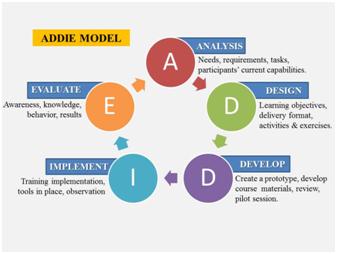Analysis
In this first phase, instructional need, goals and objectives are established. The learning environment and learner’s existing knowledge and capabilities are identified.
Design
This phase covers learning objectives, assessment instruments, exercises, content, subject matter analysis, lesson planning and media selection. It is systematic and specific, using logic to identify, develop and evaluate a set of planned strategies targeted for attaining the learning goals.
Development
This phase is meant to create and assemble the training content assets designed. The project is reviewed and revised according to client stakeholder feedback.
Implementation
During this phase, a procedure for training is developed, including the course curriculum, learning outcomes method of delivery, software tools and testing procedures.
Evaluation
Both formative and summative evaluations are required throughout the program stages. This includes tests designed to validate learning objectives have been met, as well as providing opportunities for user feedback accordingly.

